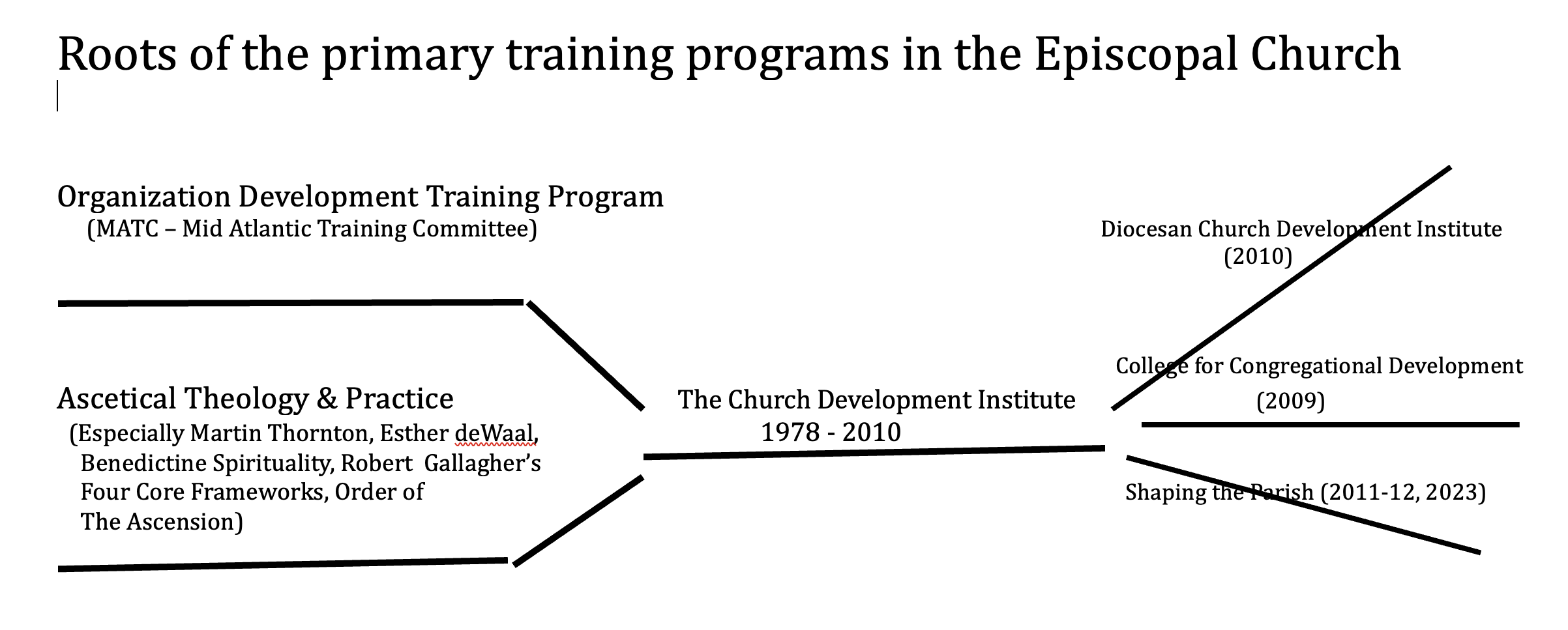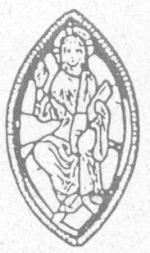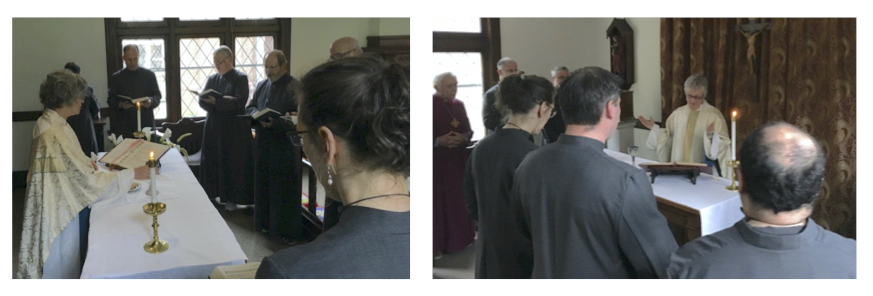Vital Christian Communities: 12 Characteristics of Healthy Congregations A review
 Thursday, May 18, 2023 at 09:58AM
Thursday, May 18, 2023 at 09:58AM  Vital Christian Communities was written by Philip Brochard and Alissabeth Newton and made available through Church Publishing in 2022. FROM AMAZON
Vital Christian Communities was written by Philip Brochard and Alissabeth Newton and made available through Church Publishing in 2022. FROM AMAZON
I’ll begin with the review I posted on Amazon where I gave it a 4 star rating. That is followed by the promised more detailed review.
Connecting the methods and theory of organization development to the church.
Reviewed in the United States on October 24, 2022
Helping the church become a healthier and more faithful community has a long history. In our time the primary thread begins with Loren Mead's bringing the field of organization development into the life of the Episcopal Church in the 1960s beginning with Project Test Pattern and Alban Institute, which continued in the Church Development Institute and the Order of the Ascension, and now to the College for Congregational Development. "Vital Christian Community" is the latest written offering to connect the methods and theory of organization development to the church.
The writers do a nice job of relating theory and models to stories of churches seeking a better and healthier life. The later chapters give special attention to the role of collaboration in that holy work. I like how they both note that parish leaders need to step away from seeing themselves as the sole driver of change while also stressing the essential and difficult role in which "leaders build communities that work together on change." In several cases their exploration of particular models could be improved. I'll return to that in another forum.
I enjoyed reading the afterword, an interview with Greg Rickel the Bishop of the Diocese of Olympia. He is a graduate of the Church Development Institute (the program then located at Sewanee) and brought that background and his skills as a leader and innovator to the task of strengthening the churches of the diocese. He acknowledges the importance of leaders gaining significant training as he refers to his own life.
Q - How did it come to you to do this kind of congregational development?
A - It came to me after doing this all myself. I took congregational development training when I was serving as a new priest and it was life changing for me and for my congregation. Once I became a bishop and realized I could have an impact on an entire diocesan system.
When he responses to a question about the benefits of such training he sets himself directly in the historical line beginning with Loren Mead. He said, "A common language for sure. I would also say confidence. Our people are far more confident that they indeed can organize, create, innovate, and even grow! They believe it." I recall Loren telling the story from the 1960s of a congregation stuck in a kind of despair and paralysis. The breakthrough was when they worked together to have a pizza party.
----------------------------------------------
Additional thoughts
The first chapter is a discussion of Melissa Skelton’s “Gather-Transform-Send” model. I’m going to offer this review in terms of that first chapter. That chapter focuses on the primary model used in the College for Congregational Development. It expresses both the best features, along with a few places where the book could be strengthened.[1]
“Gather-Transform-Send (GTS) is a model that can be used as a lens for understanding, analyzing, and helping your congregation articulate and live into its core purpose.”[2] When I first learned of the GTS model what came to mind was the Holy Eucharist. Sunday after Sunday, the Eucharistic community gathers, is transformed, and sent. Evelyn Underhill wrote, “For the fully Christian life is a Eucharistic life: that is, a natural life conformed to the pattern of Jesus, given in its wholeness to God, laid on His altar as a sacrifice of love, and consecrated, transformed by His inpouring life, to be used to give life and food to other souls.”[3] The GTS model may help churches live in the Eucharistic life on those occasions when we need to reflect on and design improvements and ways to adapt to changing needs and conditions. The model’s inclusion of “context” as a factor highlights the truth that our living of the Eucharist life requires adaptation if we are to be faithful in the specific culture and circumstances of a given parish church.
The authors offer several concrete examples of how parishes manage gathering or transformation or being sent. I enjoyed Alissa Newton’s description of her introduction to the Episcopal Church as she participate in Sunday evening Compline at St. Mark’s Cathedral in Seattle. “The first time Alissa attended she was struck by the spacious, stark cathedral sanctuary, the beautiful, solemn compline chant of the choir … Coming to compline was a transformative experience for Alissa, ultimately drawing her toward both a deeper, more intentional faith practice and eventually a vocation within the Episcopal church.”[4] In that description the authors also affirm the work of the Holy Spirit within the GTS process, i.e., “it is God who calls people to your community to be gathered, it is God who moves through the gathered community, transforming it in ways that are both expected and surprising.”[5]
Descriptive and prescriptive
The GTS model is descriptive and prescriptive. It tells us about some of the natural dynamics of the parish church. This is the work of the Holy Spirit. It’s part of every parish’s life, though more fully expressed in some places. It also suggests ways in which a church can cooperate with that work of the Holy Spirit. We can improve. That organic reality is true of other models presented in the book. In Chapter Three they present the Faith Development in Community model. It’s a variation on the Shape of the Parish model that many of you are familiar with. Both models rely on the Spirit’s movement. Martin Thornton descripted this way, “power from the center pervades the whole.”[6] The same dynamic would be true in the Sources of Transformation model, a variation on the earlier Christian Life Model.[7] You can find examples of many such models at Shaping the Parish Resources.
Under the tip of the iceberg
In Chapter 7 :Reflective, the writers explore the Iceberg model. First used by Kurt Lewin, it’s been part of the organization development from the beginning of the field. We Christian’s have noted the underlying reality to it -- we believe in things seen and unseen, visible and invisible. In their initial discussion of the GTS model they say, “But Transform asks us to also look at the less visible things, the parts of congregational culture that are the very air we breathe and so are sometimes difficult to see, such as: How are children treated here? What happens when there is conflict? How is money discussed? Who is invited into leadership, and how? Who preaches? Is there silence?”[8]
Much of the work of parish development is in helping people discover and productively engage the more hidden aspects of church life. Vital Christian Community is a useful resource to that end.
Purpose
Let’s revisit the statement about purpose, “Gather-Transform-Send (GTS) is a model that can be used as a lens for understanding, analyzing, and helping your congregation articulate and live into its core purpose.” And, “Every faith community that worships or gathers in any way is engaged in this purpose, and every congregation can improve, adapt, and engage this core purpose more deeply than they currently do.” [9]
The GTS model is a specific application of a much older model used in organization development work. The Transformation Model is Inputs – Transformation Process – Outputs. That model wouldn’t be understood as being a “purpose” for an organization but would be seen as a process by which the purpose is achieved. I can see GTS as describing a parish’s purpose, if I think of it in terms of the Holy Eucharist, i.e., “laid on His altar as a sacrifice of love, and consecrated, transformed by His inpouring life, to be used to give life and food to other souls.”[10]
My preference is to look at the purpose issue in broader terms. Michelle Heyne and I have suggested that any parish church has three intrinsic purposes:
1. The worship of God
2. The formation of the People of God for the sake of the world
3. Being a sanctifying presence in the broader community
“These purposes aren’t something we create ourselves. They are the innate, natural functions of the local microcosm of the Body of Christ, the parish church. We may engage them effectively or not. We may adequately understand the issues and dynamics within them or not. The parish may have a high level of commitment and competence in regard to them or not. They are our underlying reasons to exist regardless of whether we are effective, comprehending, and committed.”[11]
The GTS model can be interpreted to include a broader view of purpose. I think it’s useful to be more direct about the parish existing for the worship of God and being a sanctifying presence in the larger community.
IGOIS
The authors make use of Alice Mann’s incorporation model[12] to give flesh to the Gather element of GTS. Mann’s model has five phases: Invite, Greet, Orient, Incorporate, Send IGOIS). Vital Christian Community uses the first four as a way to understand what is involved in their Gather phase. This makes use of what I think of as “level 1” of Mann’s model. The authors give examples of the first four phases that are broad enough for most parish leaders to say, “oh yes, we do that.” There are suggestions of tangible ways to improve each stage.
The difficulty comes when we note that Mann’s model has Send as it’s fifth element. So, where in Mann’s model is transformation?
The transformation occurs in the midst of the earlier four stages. As we invite, greet, orient, and incorporate people are transformed. It’s actually the way which people are incorporated into the body, and depending on their growth in faith and practice, they go forth, they are sent.[13]
It is not that we invite, orient, greet, incorporate and then a transformation process takes place. It is as we invite, greet, orient, and incorporate, transformation takes place. In the process of becoming part of the Body of Christ transformation takes place.
Vital Christian Community makes good use of the Renewal-Apostolate Cycle in describing the Transform and Send phases. They don’t directly credit the earlier model but it’s not much of a leap to see how the description of those phases draws on the language and logic of the Renewal-Apostolate Cycle.[14]
A shadow over the book
The primary shadow that exists over the book, and the College for Church Development (CCD), is an unwillingness to acknowledge and incorporate, its origins. That said, CCD appears to be a wonderful program. But the hesitation to acknowledge the extent to which CCD build upon the culture, structures and processes of CDI would seem to be continued in this book. There are a number of places in the book where it appears that the authors are avoiding proper recognition of my work. The material below is some of the background related to the problem.

The acknowledgment issue in Vital Christian Community
Alissa Newton was a participant in the national Church Development Institute (CDI) in 2006 and 2007. Robert Gallagher was the director of the program and Michelle Heyne was on the training staff. Alissa also served as an intern on the training staff in 2008. Later she served on the CDI staff in the Diocese of Northern Indiana where the 2008 CDI manual was used. She would have been familiar with just about all the models and have documents with the proper copyright statements on them.
I sent a series of messages to Church Publishing on corrections I thought were needed. Neither I or Ascension Press were going to take the writers or Church Publishing to court over this. Church Press assured us that they would look into the matter. Our hope is that at some corrections were made in the book. A PDF of the messages to Church Publishing.
The Living Church article
“Both organizations draw rave reviews from participants. It is difficult to pin down how the programs differ, even after talking to nearly a dozen people. some leaders and former leaders of the programs declined to talk about differences, saying they are less familiar with the other program, similarities, on the other hand, are easy to find.” Kirk Petersen in “Two Schools of Congregation Development”, The Living Church, April 8, 2018 Peterson goes on to list some of the similarities.
A PDF of the Living Church article “Two Schools of Congregation Development”
And “Two Schools of Congregation Development” - by the same name, posted on “Means of Grace, Hope of Glory”. On the web HERE
Olympia pays licensing fee
“The Diocese of Olympia has recognized the extent of its debt to CDI in an agreement to pay a licensing fee to CDI Trainers for a five-year period,” Gallagher has written on congregationaldevelopment.com. Rickel said via email that “though all our attorneys were clear that we did not have to do this, acknowledging our debt to them, we did agree to a five year fee for that. We are no longer paying that.” He added, “Over these years we have both evolved very differently. I took CDI and I am very grateful for its vision and what it taught me.” The Living Church, April 8, 2018
My own view is that I’d rather have the clear statement of the debt, which the bishop acknowledges, than the small licensing fee that CDI received from the diocese. CDI pressed the fee issue because we were not hearing such clarity at the time.
Training of the College for Congregational Development (CCD) Program leadership
All of the core trainers/developers of the College for Congregational Development (CCD) received their training in parish development through the Church Development Institute. Several of them also received related training from other groups. The diocesan bishop was also trained by CDI – Sewanee. Melissa Skelton had been a trainer with CDI for a number of years. It would be natural enough for her to build what she was doing in CCD on that experience. The difficulty is what that debt isn’t openly and fully acknowledged.
The elements of Church Development Institute (CDI) that provided the basic structure of the College for Congregational Development (CCD) Program
Over a period of about 20 years Robert Gallagher, at times in consultation with other CDI trainers, shaped a particular form of training for parish development. Robert was a trainer in the MATC (Mid-Atlantic Training Committee) system. He was involved with coordinating and staffing lab training in organization development, consultation skills, group development, conflict management, educational design, and human interaction. And in 1978 he launched what, in time, became the Church Development Institute (CDI).
Over those 20 years there were contributions to all the core elements from the many trainers that served on staff. However, Robert Gallagher was the director and the primary educational designer. None of those changes were contributed to by those who became the College for Congregational Development (CCD) training staff.
CCD inherited the skeleton and muscles of what makes for an effective parish development training program.
A PDF “The elements of an effective parish development training program”
A document “The History of Parish Development in the Episcopal Church (2023)
Finally, buy the book
Let me stress, the book is an excellent resource for any church interested in its health and vitality. The writers do a nice job of presenting a mix of theory and stories of application. FROM AMAZON
rag+
[1] The question of what the strengths or weakness of a book or program might be are always subjective. So, my comments are about me, my preferences, my biases, and the lenses I look through.
[2] From Vital Christian Community
[3] From The Mystery of Sacrifice, Evelyn Underhill
[4] From Vital Christian Community
[5] From Vital Christian Community
[6] From Pastoral Theology: A Reorientation, Martin Thornton FROM WIPF
[7] The Christian Life Model can be found in Fill All Things: The Spiritual Dynamics of the Parish Church, Robert A. Gallagher, 2008 (From Amazon) and in the earlier Power from on High: A Model for Parish Life and Development by Robert Gallagher, OA. (PDF) The authors misattribute the model suggesting it’s Martin Thornton work. The triangle of Worship – Doctrine – Action is commonly used by many Anglican writers. As far as I know I was the first to turn the triangle into a parish development model.
[8] From Vital Christian Community
[9] From Vital Christian Community
[10] From The Mystery of Sacrifice, Evelyn Underhill
[11] From An Energy Not Its Own: Three cycles of parish life and the purposes of the parish church, Michelle Heyne & Robert Gallagher, to be published in 2023. The first chapter is “The Purposes of the Parish Church.” That approach is also offered in our Introduction to A Wonderful and Sacred Mystery: A Practical Theology of the Parish Church, 2021 AMAZON
[12] Incorporation of New Members in the Episcopal Church: A Manual for Clergy and Lay Leaders, Alice Mann, Ascension Press, 1983. FROM AMAZON When I was the congregational development officer in the Diocese of Connecticut, we used that model in our training programs. One of the bishops had IGOIS buttons made and passed out at convention.
13. I understand that in a sense the church sends people. We are sent from the Eucharist, i.e., “Send us now into the world in peace.” But it would also be true to say that they simply return. We’re not actually sending people any place after the Eucharist. They are returning to their apostolate within the routine of life with family and friends, in workplace and civic life.
14 The Renewal-Apostolate Cycle is a chapter in Fill All Things: The Spiritual Dynamics of the Parish Church, Robert A. Gallagher, Ascension Press, 2008. AMAZON An exploration of the model is also offered as a chapter in the upcoming book An Energy Not Its Own: Three cycles of parish life and the purposes of the parish church, Michelle Heyne & Robert Gallagher, Ascension Press, 2023.




